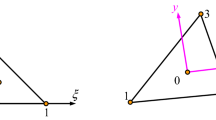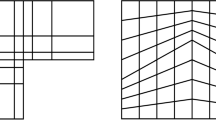Abstract
An eight node brick Cosserat point element (CPE) has been developed for the numerical solution of three-dimensional problems of hyperelastic nonlinear orthotropic elastic materials. In the Cosserat approach, a strain energy function for the CPE is proposed which satisfies restrictions due to a nonlinear form of the patch test. Part of the strain energy of the CPE is characterized by a three-dimensional strain energy function that depends on physically based nonlinear orthotropic invariants. Special attention has been focused on developing closed form expressions for constitutive coefficients in another part of the strain energy that characterizes the response to inhomogeneous deformations appropriate for orthotropic material response. A number of example problems are presented which demonstrate that the CPE is a robust user friendly element for finite deformations of orthotropic elastic materials, which does not exhibit unphysical locking or hourglassing for thin structures or nearly incompressible materials.
Similar content being viewed by others
References
ABAQUS, Version 6.9EF1. ABAQUS, Providence
Belytschko T, Bindemann LP (1986) Assumed strain stabilization of the 4-node quadrilateral with 1-point quadrature for nonlinear problems. Comput Methods Appl Mech Eng 54: 279–301
Belytschko T, Bindemann LP (1993) Assumed strain stabilization of the eight node hexahedral element. Comput Methods Appl Mech Eng 105(2): 225–260
Belytschko T, Ong JS-J, Liu WK, Kennedy JM (1984) Hourglass control in linear and nonlinear problems. Comput Methods Appl Mech Eng 43: 251–276
Bonet J, Bhargava P (1995) A uniform deformation gradient hexahedron element with artificial hourglass control. Int J Numer Methods Eng 38(16): 2809–2828
César de Sá JMA, Areias PMA, Jorge RMN (2001) Quadrilateral elements for the solution of elasto-plastic finite strain problems. Int J Numer Methods Eng 51(8): 883–917
Cowin SC, Van Buskirk WC (1986) Thermodynamics restrictions on the elastic constants of bone. J Biomech 19(1): 85–87
Crisfield MA, Moita GF, Lyons LPR, Jelenic G (1995) Enhanced lower-order element formulations for large strains. Comput Mech 17(1–25): 62–73
Fredriksson M, Ottosen NS (2007) Accurate eight-node hexahedral element. Int J Numer Methods Eng 72(6): 631–657
Green AE, Adkins JE (1960) Large elastic deformations and non-linear continuum mechanics. Clarendon Press, Oxford
Hutter R, Hora P, Niederer P (2000) Total hourglass control for hyperelastic materials. Comput Methods Appl Mech Eng 189(3): 991–1010
Jabareen M, Rubin MB (2007) Hyperelasticity and physical shear buckling of a block predicted by the Cosserat point element compared with inelasticity and hourglassing predicted by other element formulations. Comput Mech 40(3): 447–459
Jabareen M, Rubin MB (2007) An improved 3-D Cosserat brick element for irregular shaped elements. Comput Mech 40: 979–1004
Jabareen M, Rubin MB (2008) A generalized Cosserat point element (CPE) for isotropic nonlinear elastic materials including irregular 3-D brick and thin structural elements. J Mech Mater Struct 3(8): 1465–1498
Jabareen M, Rubin MB (2008) Modified torsion coefficients for a 3-D brick Cosserat point element. Comput Mech 41(4): 517–525
Jaquotte OP, Oden JT (1986) An accurate and efficient a posteriori control of hourglass instabilities in underintegrated linear and nonlinear elasticity. Comput Methods Appl Mech Eng 55: 105–128
Kasper E, Taylor RL (2000) A mixed-enhanced strain method. Part I: geometrically linear problems. Comput Struct 75: 237–250
Kasper E, Taylor RL (2000) A mixed-enhanced strain method. Part II: geometrically nonlinear problems. Comput Struct 75: 251–260
Klepach D, Rubin MB (2006) Influence of membrane stresses on postbuckling of rectangular plates using a nonlinear elastic 3-D Cosserat brick element. Comput Mech 39(6): 729–740
Lekhnitskii SG (1963) Theory of elasticity of an anisotropic elastic body. Holden-Day, San Francisco
Loehnert S, Boerner EFI, Rubin MB, Wriggers P (2005) Response of a nonlinear elastic general Cosserat brick element in simulations typically exhibiting locking and hourglassing. Comput Mech 36(4): 255–265
Maple, Version 13. Maplesoft Math Software, Waterloo
Mueller-Hoeppe DS, Loehnert S, Wriggers P (2009) A finite deformation brick element with inhomogeneous mode enhancement. Int J Numer Methods Eng 78: 1164–1187
Nadler B, Rubin MB (2003) A new 3-D finite element for nonlinear elasticity using the theory of a Cosserat point. Int J Solids Struct 40: 4585–4614
Pian THH (1964) Derivation of element stiffness matrices by assumed stress distributions. AIAA J 2(7): 1333–1336
Pian THH, Sumihara K (1984) Rational approach for assumed stress finite elements. Int J Numer Methods Eng 20: 1685–1695
Reese S, Wriggers P (1996) Finite element calculation of the stability behaviour of hyperelastic solids with the enhanced strain methods. Z Angew Math Mech 76(S5): 415–416
Reese S, Wriggers P (2000) A stabilization technique to avoid hourglassing in finite elasticity. Int J Numer Methods Eng 48: 79–110
Reese S, Wriggers P, Reddy BD (2000) A new locking-free brick element technique for large deformation problems in elasticity. Comput Struct 75: 291–304
Rubin MB (1985) On the theory of a Cosserat point and its application to the numerical solution of continuum problems. ASME J Appl Mech 52: 368–372
Rubin MB (1985) On the numerical solution of one-dimensional continuum problems using the theory of a Cosserat point. ASME J Appl Mech 52: 373–378
Rubin MB (1995) Numerical solution of two- and three-dimensional thermomechanical problems using the theory of a Cosserat point, theoretical, experimental, and numerical contributions to the mechanics of fluids and solids: a collection of papers in honor of Paul M. Naghdi, edited by J. Casey and M. J. Crochet, Birkäuser, Basel. Spec Issue Z Angew Math Phys 46:308–334
Rubin MB (1996) Restrictions on nonlinear constitutive equations for elastic rods. J Elast 44: 9–36
Rubin MB (2000) Cosserat theories: shells, rods and points., solid mechanics and its applications. Kluwer, Dordrecht
Rubin MB, Jabareen M (2008) Physically based invariants for nonlinear elastic orthotropic solids. J Elast 90: 1–18
Rubin MB, Jabareen M (2010) Further developments of physically based invariants for nonlinear elastic orthotropic solids. Accepted for publication in J. Elast 103:289–294
Simo JC, Armero F (1992) Geometrically nonlinear enhanced strain mixed methods and the method of incompatible modes. Int J Numer Methods Eng 33: 1413–1449
Simo JC, Rifai MS (1990) A class of mixed assumed strain methods and the method of incompatible modes. Int J Numer Methods Eng 29(8): 1595–1638
Simo JC, Armero F, Taylor RL (1993) Improved versions of assumed enhanced strain tri-linear elements for 3D finite deformation problems. Comput Methods Appl Mech Eng 110(3–4): 359–386
Sussmann T, Bathe KJ (1987) A finite element formulation for nonlinear incompressible elastic and inelastic analysis. Comput Struct 26(1–2): 357–409
Wriggers P, Korelc J (1996) On enhanced strain methods for small and finite deformations of solids. Comput Mech 18: 413–428
Wriggers P, Reese S (1996) A note on enhanced strain methods for large deformations. Comput Methods Appl Mech Eng 135: 201–209
Author information
Authors and Affiliations
Corresponding author
Rights and permissions
About this article
Cite this article
Jabareen, M., Sharipova, L. & Rubin, M.B. Cosserat point element (CPE) for finite deformation of orthotropic elastic materials. Comput Mech 49, 525–544 (2012). https://doi.org/10.1007/s00466-011-0654-x
Received:
Accepted:
Published:
Issue Date:
DOI: https://doi.org/10.1007/s00466-011-0654-x




